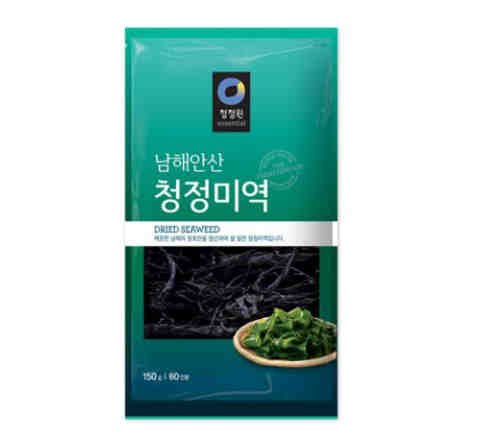Miyeok: The Sea Vegetable to Add to Your Meals
Dried Miyeok is dried seaweed and is different from Gim (dried seaweed sheets).
You may want to read: All You Need to Know About Korean Gim
You may be wondering, as I did, if Gim is made from Miyeok- and the answer is that it’s made from different types of seaweed (I know, seaweed has types??). Gim is from the Porphyra genus (red algae) and Miyeok’s exotic scientific name is Undaria Pinnatifida (brown algae).
Help me pronounce it! “Me-Yuck!”
This package of dried crunchy bunch of twisty sticks is usually stocked in the Korean kitchen to make Korean Birthday Soup (it’s not illegal to eat it on other days though lol). The reason is that Miyeok Guk (Seaweed Soup), with its specific nutritional properties, is considered a very health-boosting meal.
Traditionally, mothers in Korea will be given this Birthday Soup by the bucketful after giving birth. Seaweed contains iron, iodine and calcium (among other nutrients: Benefits of Seaweed- MedicalNewsToday) that’s believed to promote recovery from giving birth and to boost milk supply. Because of this, people have subsequently prepared it on their birthday to take a moment to remember their mothers every year. Ta-da, tradition.
One thing to note is that re-hydrating this dried ingredient will result in a much larger amount than you expect! For one person, break off a tiny amount- like only as much as a tiny 2-yr old’s fist will hold and start from there.
OPPA and I both have personal rookie experiences from youth that resulted in an overflowing bowl of monster seaweed. There are also cases of people who have mindlessly nibbled large amounts of it dry like chips and have to go to the hospital because it expands in the stomach. You have been warned.
Everything in moderation, friends, lol.
If this happens by the way (you rehydrate way too much), you can squeeze out the excess water and store in a Ziploc bag and store it in the fridge- consume it in a couple of days though before it becomes slimy.
Simplistic Korean Birthday Soup Recipe
Dried Seaweed 미역 (Miyeok)
Toasted Sesame Oil 참기름 (Chamgireum)
Dried Anchovy Powder/Fish Sauce/Salted Shrimp
Garlic
Soy Sauce
Beef
What to do:
Re-hydrate seaweed* by adding dried seaweed in a large bowl of water for 10 minutes.
Fry beef in a bit of sesame oil until the red begins to turn brown. Set aside.
Squeeze out excess water from seaweed, and cut* to bite sized pieces if you like. Stir fry the seaweed in a bit of sesame oil. Lightly cook for only a few minutes. Set aside.
Add water to a pot. Add meat and seaweed. Add garlic.
Flavour soup* with anchovy powder and soy sauce. Alternatively you can add fish sauce/salted shrimp or even just salt (the way OPPA likes it).
Bring to a boil and eat*.
* Remember to control the amount! A single serving can be as little as a heaping tablespoon of dried seaweed.
* If you purchase 실미역 (means Thread Seaweed), it will be thinner strands of seaweed- so when you break it off, it may not need cutting. After it’s been rehydrated, judge for yourself whether you want to cut it or not.
* You can either flavour the soup or add the flavouring ingredients (soy sauce/fish sauce) to the meat and seaweed and then add water. Your call.
* Some people will bring to a boil, turn off the heat, and bring to a second boil. Depends how hungry you are 😁.
Oh, and some people omit soy sauce completely and only season with fish sauce. Totally up to you. You could technically season the entire soup with just salt (OPPA’s preferred method). I’d say to choose at least one you have/like in regards to soy sauce or fish sauce because it really adds flavour (my personal preference).
Delicious with piping hot with a bowl of rice, don’t forget the kimchi!
You can also use this ingredient to make Korean Banchan (side dish).
Miyeok Muchim (Korean Bapsang): Refreshing sweet and sour (vinegar) side dish reminiscent of a seaweed salad (with addition of cucumbers). Great companion to Korean BBQ meats.
How to Store Dried Seaweed
Store in a cool, dark place- like a pantry drawer. Moisture is the enemy, so avoid humidity.
Enjoy, as with all things, in moderation as consuming excessive of iodine can lead to hyperthyroidism (source: keep in mind the word “excessive” here).

